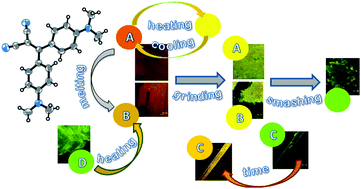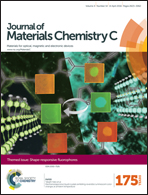Polymorphism-dependent aggregation induced emission of a push–pull dye and its multi-stimuli responsive behavior†
Abstract
A comprehensive optical investigation of 1,1-dicyano-2,2-bis(4-dimethylaminophenyl)ethylene (1) is presented. The compound crystallizes in four different forms all displaying AIE behavior. The crystalline forms A and B are yellow-orange-emissive, while C and D are green-emissive. On the basis of X-ray structural analysis, the weak intermolecular interactions account for restricted internal rotations, leading to fluorescence enhancement in the crystals; however, the difference in emission color is ascribed to the various conformations of the molecules in the four crystalline forms. In addition, the emission color of crystals of A can be tuned by heating and grinding, that of B by grinding only, while crystals of C show chronochromic behavior. An explanation for such a rich variety of luminescence behavior is formulated here through the use of steady state and time resolved photoluminescence, X-ray diffraction analysis and DFT and TDDFT calculations. The involved chromic mechanism appears to be mainly associated with surface defects induced by the external stimuli rather than an amorphization process, as frequently observed for other stimuli responsive compounds.

- This article is part of the themed collection: Shape-Responsive Fluorophores


 Please wait while we load your content...
Please wait while we load your content...